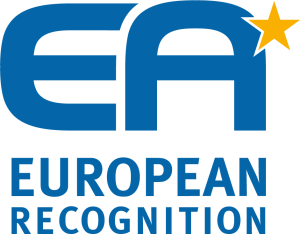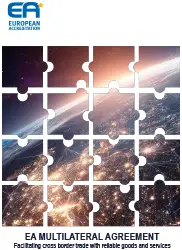Introduction
What is the EA MLA?
The main purpose of the EA MLA is to provide confidence to all interested parties in conformity assessment results provided by CABs accredited by EA MLA signatories with the aim of facilitating the acceptance in the marketplace of conformity assessment results provided by CABs accredited by EA MLA signatories.
Such acceptance has a major importance for the development of industry and business opportunities by removing the need to repeat the accredited conformity assessment in different countries. Therefore, the EA MLA contributes to increasing the competitiveness of European products and services eliminating technical barriers to trade, reducing costs and adding value to businesses and consumers.
Regulation (EC) No 765/2008
National authorities (within the EU) shall recognize the equivalence of the services delivered by those National Accreditation Bodies (NAB) (from EU Member States) which have successfully undergone EA peer evaluation (EA MLA signatories) and thereby accept the accreditation certificates of those bodies and the attestations issued by the Conformity Assessment Bodies accredited by them.
How to verify a Certificate or Report is covered by accreditation
The mark of an EA MLA signatory on certificates and reports issued by accredited Conformity Assessment Bodies acts as a “passport to trade”. It is the preferred means to create confidence in accreditation and to demonstrate that a certificate or report is covered by the (scope of) accreditation.

Follow these four simple steps
to check the reliability of a certificate or a report:
Check that there is an accreditation mark on the report or certificate.
Check that the accreditation mark is of a National Accreditation Body (NAB) signatory to the EA, ILAC or IAF MLA.
Note:
- A CAB established in the EEA shall be accredited by its NAB.
- Only reports and certificates issued by a CAB accredited by an EEA NAB signatory to the EA MLA will be accepted in EU regulated sectors.
Check that the conformity assessment results on the report or certificate are covered by the scope of accreditation.
If in doubt, contact the relevant NAB directly.
For current signatory scopes, consult EA’s Directory of MLA Signatories.
To read our brochure
“EA MULTILATERAL AGREEMENT Facilitating cross-border
trade with reliable goods and services”
Coverage
Scopes & Standards
Accreditation scope /
Activities
Standards used
for accreditation
Laboratories
Testing and Medical examination
EN ISO/IEC 17025
EN ISO 15189
Laboratories
Calibration
EN ISO/IEC 17025
Certification Bodies
Product certification
EN ISO/IEC 17065
Certification Bodies
Certification of persons
EN ISO/IEC 17024
Certification Bodies
Management systems certification
EN ISO/IEC 17021-1
Inspection Bodies
Inspection
EN ISO/IEC 17020
Validation and Verification Bodies
Validation and Verification
EN ISO/IEC 17029
Proficiency Testing Providers (PTP)
Proficiency Testing Providers
EN ISO/IEC 17043
Reference Materials Producers (RMP)
Reference Materials Producers
EN ISO 17034
Biobanking
Biobanks
EN ISO 20387
EA MLA for Biobanking
The EA General Assembly decided to expand the EA MLA for biobanking as a level 2 conformity assessment activity using EN ISO 20387 as a new level 3 normative document.
The EA Multilateral Agreement Council concluded all arrangements, including the training of its members, who are making the decisions, to start with the peer evaluations of EA National Accreditation Bodies.
All conformity assessment results (e.g. reports and certificates) provided by Conformity Assessment Bodies accredited by an EA MLA signatory are considered to be under the EA MLA provided that the conformity assessment results issued by the CAB contain a reference to the relevant accreditation.
Regulation (EC) No 765/2008 places an obligation on EU Member States to accept results issued by the conformity assessment bodies accredited by EA (EEA) MLA signatories. This clearly removes the need for a product to be re-tested or re-certified when marketed on different markets in the EU, provided that the certificate is covered by valid accreditation.
To confirm equivalence of accreditation activities or validity of reports and certificates issued by accredited bodies, EA Members can use EA-INF/04 Statement on acceptance and recognition of activities under the EA MLA and issue a “statement of equivalence” in response to requests made by regulators or other users.
Benefits
For national governments and regulators
- Supporting implementation of European and national legislations by confirming compliance with standards and applicable requirements;
- Enhancing trade and economic growth by giving governments confidence in accreditation and competent suppliers of goods and services;
- Limiting costs and resources by eliminating a number of administrative obligations. The EA MLA reduces the need to employ specialized assessment personnel for regulatory controls and avoids duplication of audits.
For industry and the business community
- Boosting competitiveness: with the EA MLA, businesses can differentiate their services by providing objective evidence of technical competence, impartiality and compliance with international requirements and avoid the costs of re-testing;
- Reducing controls and increasing quality: importing goods and services with an EA MLA accredited report or certificate can be both less risky and cheaper as businesses do not need to provide additional evidence;
- Supporting export: as the EA MLA is recognized internationally, it opens new opportunities on the global market by eliminating barriers to trade.
For Consumers and Citizens
- Creating trust: consumers’ confidence in the market is enhanced when they know that the products and services they choose are controlled by an independent and competent body which is itself regularly assessed by an impartial body;
- Operating in the public interest: all along the supply chain, consumers’ interest is safeguarded by the EA MLA Signatories who act as “checkers of checkers”.
- Providing citizens and consumers with a better and safer environment, and better healthcare services by guaranteeing the compliance of products and services with European legislations
To read our brochure
“EA MULTILATERAL AGREEMENT Facilitating cross-border
trade with reliable goods and services”
Why it matters
The EA MLA acts as a passport to trade, boosting the efficiency of Europe’s Single Market. It is internationally recognised through ILAC and IAF agreements, supporting acceptance worldwide.
FAQ
A harmonised standard is a European standard developed by a recognised European Standards Organisation: CEN, CENELEC, or ETSI. It is created following a request or mandate from the European Commission to one of these organisations. Manufacturers, other economic operators, or conformity assessment bodies can use harmonised standards to demonstrate that products, services, or processes comply with relevant EU legislation. When a product is designed or manufactured following harmonized standards, it means that the product is in line with corresponding EU rules. In other words, the product benefits then from the presumption of conformity.
Presumption of conformity exists when a product is designed or manufactured in accordance with harmonized standards which have been published in the Official Journal of the European Union.
We talk here about presumption of conformity with the accessibility requirements set out in Directive (EU)2019/882.



